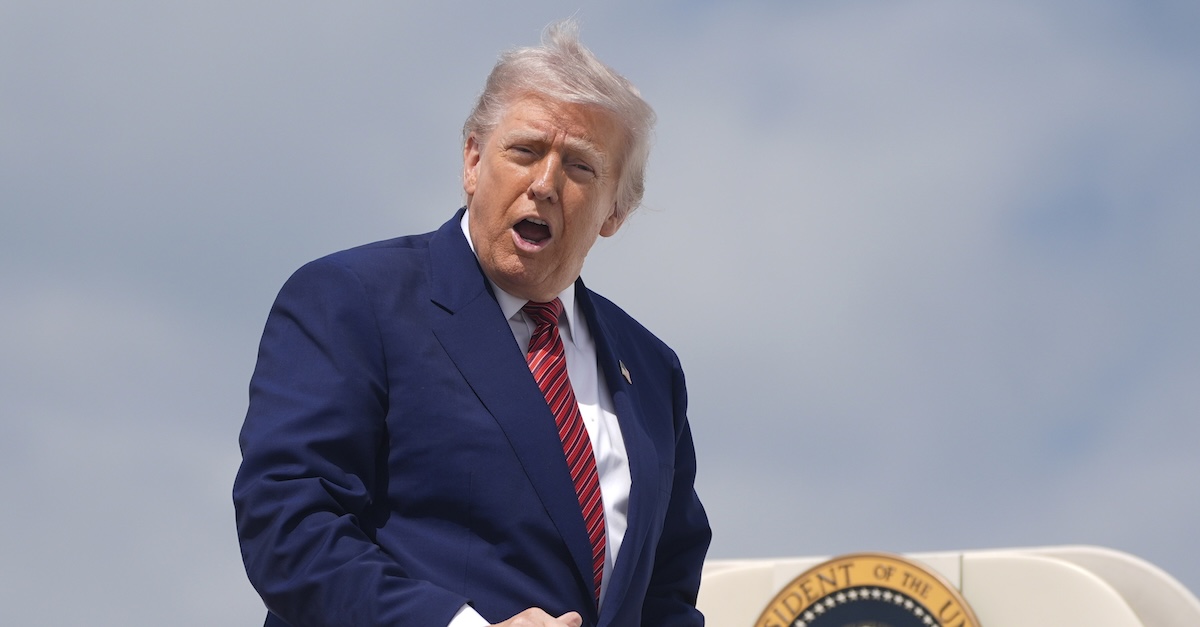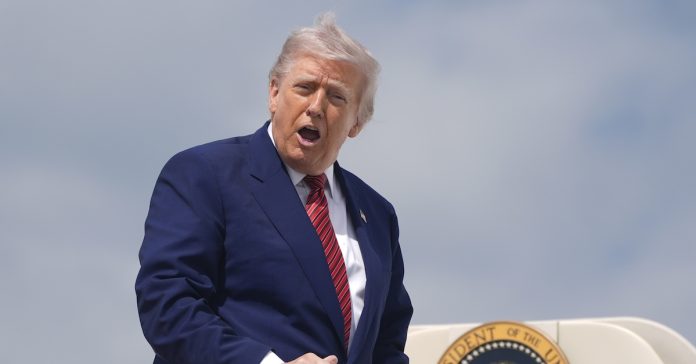
President Donald Trump boards Air Force One to depart Joint Base Andrews, Md., Friday, May 23, 2025 (AP Photo/Manuel Balce Ceneta).
A federal appellate court on Friday refused to stay a judge”s order directing the Trump administration to start reinstating National Institutes of Health (NIH) research grants that got slashed earlier this year — saying it sees “no obvious error” in the lower court’s conclusion that the government’s actions “bear all the hallmarks of arbitrary and capricious decision-making.”
In a unanimous ruling, the U.S. Court of Appeals for the First Circuit rejected a government motion to stay a July 2 final order by U.S. District Judge William Young, a Ronald Reagan appointee, where he declared that the Trump administration acted “unlawfully” and in “haste to appease the Executive,” resulting in a “disruption of grants” that was illegal under the Administrative Procedure Act (APA).
The First Circuit said Friday that the plaintiffs — a coalition of public health organizations led by the American Public Health Association and other advocacy groups — provided “concrete examples” of economic and non-economic harms to themselves, to the public at large, and to the “scientific and medical advancements” of the United States if a stay were granted. Trump’s Justice Department, meanwhile, did not dispute the court’s “critical findings” that the terminations of hundreds of other grants were “unreasonable,” per the appellate court’s ruling.
“The Department fails to address any of the non-monetary harms that the plaintiffs detailed, which cannot be remedied by belated payment,” the First Circuit said. “Thus, the Department has failed to show that the plaintiffs would not suffer substantial harm if the district court’s orders were stayed during the pendency of the litigation.”
Love true crime? Sign up for our newsletter, The Law&Crime Docket, to get the latest real-life crime stories delivered right to your inbox
The First Circuit noted now the government does not refute the plaintiffs’ contentions that a stay would result in the setback of “life-saving research by years if not decades” and would eliminate funding for “urgent public health issues,” according to the appellate order. “These are serious concerns that suggest the public’s interest is aligned with the plaintiffs, at least at this stage of the proceedings, not with the Department,” the First Circuit charged.
In his July 2 ruling, Young found that the Department of Government Efficiency (DOGE) “force-fed” the NIH cancellations and approved them “within two minutes” of the email requests being sent. “Every Administration has political priorities and enjoys the ability to make policy changes,” the judge said. “But the agencies that implement those changes have to have a reasoned and reasonable explanation for doing so.”
The district court concluded that the government’s decisions “rested on circular reasoning, included no explanation for the about-face in agency-wide policy, and entirely ignored significant reliance interests,” according to the First Circuit. “For example, the [lower] court concluded that the prohibited categories of research grants were never defined, thus allowing the Department to terminate any grant that it wanted to, for any reason,” the appellate order alleges.
In its motion to stay the July 2 order, the Trump administration asserted that NIH reviewed its grant portfolios to “identify and cancel specific grants that no longer serve agency priorities.” But the government provided no record citation for this claim, according to the First Circuit, which points out how the district court “found the exact opposite.”
As reported by Law&Crime, the First Circuit issued a unanimous order on July 4 rejecting a request to stay a nullification order issued by Young late last month that directed the Trump administration to restore the slashed NIH research grants. The intermediary court made sure not to fault this slightly-delayed motions practice in its ruling while the government waited to fully appeal until the lower court issued its final order.
Earlier this year, President Donald Trump took aim at the NIH grants in question by way of executive orders attacking diversity, equity and inclusion (DEI) programs and so-called “gender ideology.”
The district court showcased its disdain for both executive orders and ultimately previewed its two vacatur order during a harsh judicial dressing-down in mid-June.
“I am hesitant to draw this conclusion — but I have an unflinching obligation to draw it — that this represents racial discrimination and discrimination against America’s LGBTQ community,” Young said during the bench trial in the case. “That’s what this is. I would be blind not to call it out. My duty is to call it out.”
In each successive order, the court called the government out further.
An order issued on June 23 contained merely conclusions but generally, and in all caps, found the NIH rescissions to be: “OF NO EFFECT, VOID, ILLEGAL, SET ASIDE AND VACATED.”
Colin Kalmbacher contributed to this report.

